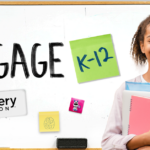Rob Waldron joined Curriculum Associates as Chief Executive Officer in 2008, bringing leadership experience from both for-profit and nonprofit education worlds. He runs the company with a long-term focus, upholding the founding mission to improve classrooms everywhere. Under his leadership, revenues have increased more than seven-fold, making Curriculum Associates the nation’s fastest-growing K–12 education publishing company. Curriculum Associates now employs 1,000 staff and has earned “Top Place to Work” status from both the Boston Business Journal and The Boston Globe.
Prior to joining, Rob served as CEO of Jumpstart, a national nonprofit preparing preschoolers from low-income backgrounds for success, and as CEO of the K12 tutoring division of Kaplan Education. Rob also served as an operating executive at private equity firm Berkshire Partners.
Winner of the Northeastern U.S. Regional YPO Social Impact Award, EdTech Digest CEO of the Year and named an EY Entrepreneur of the Year in New England, Rob’s mission-driven passion has earned him recognition as a Fast Company Top 25 Social Entrepreneur and World Economic Forum Young Global Leader. An Aspen Institute/Pahara Fellow, Rob also served as a Fellow at Harvard’s Kennedy School. Rob received his B.A. from Northwestern and M.B.A. from Harvard.
Questions:
For our readers who are having their first opportunity to learn about you and your history, what does Curriculum Associates do? Can you give a brief overview of what you provide to schools and districts?
This year we’re celebrating a milestone at Curriculum Associates—50 years partnering with schools across the U.S. Over the years, we’ve introduced a variety of innovative products to support learning in a number of ways, but our purpose has always remained constant: we want to make classrooms better places for teachers and students.
We serve over 8 million students and educators in districts across the country, providing both print and digital tools along with award-winning ongoing implementation support and professional development to help all learners meet and exceed relevant standards. Our online diagnostic and instruction tool, i-Ready, is a resource with which many of your readers may be familiar. For almost a decade now, i-Ready has helped teachers deliver personalized instruction that pinpoints students’ needs in reading and math.
We also have a number of other key resources. Ready Classroom Mathematics is our K-5 core math program, so that is a big one. We also have our Ready programs—Reading, Writing, and Mathematics—for K-8, each of which is a rigorous curriculum that uses a problem solving-based approach. And I also want to mention BRIGANCE Special Education, which supports exceptional students and their teachers at every level throughout their school career and beyond.
Across each resource, it all comes back to equitable learning programs—they have been, and continue to be, an essential part of everything we do, and we work together with educators to both raise the bar for student achievement and make it reachable for all.
Equity and accessibility are often cited as top concerns along with student privacy for school districts these days. We’re going to cover some different angles relevant to equity and accessibility but I’d also like to know, what commitment have you made to student data privacy and how does this factor into product development?
This is an excellent and important question. Adaptive technology is an exciting tool, allowing for new levels of personalization not possible in previous decades. While it offers incredible opportunities to support individual learning experiences, it also raises issues around data collection and, more importantly, protection. As we work to provide the most accessible tools to the diverse populations we serve, we are deeply committed to protecting the data of these students. Put simply, we believe that any data collected by a learning tool such as i-Ready should only be used to support student learning. Our products are compliant with all applicable laws and regulations pertaining to the protection of student data. Identifiable data is never shared with any third parties without a school’s consent and will never be sold or used for commercial gain.
Further, we have signed the Student Privacy Pledge, committing to responsible stewardship and appropriate legal use of student personal information. As you well know, this issue is one of the paramount concerns for parents and schools, and our commitment to protecting the students we serve is one we will always uphold.
What does the term educational equity mean to you?
We believe that equity in education means raising the bar and making it reachable for all. Put another way, we want to increase expectations for all students, because we understand how talented and capable our learners are, and then provide the necessary supports to make these equitable outcomes achievable.
One of the ways we keep equity top-of-mind is through our understanding that there is no such thing as a “typical” student. It’s why we support teachers’ ability to personalize and differentiate instruction as a prominent part of our programs, especially i-Ready, and why we have teams that specifically account for the needs of diverse learners, including special education students, students of all different socioeconomic backgrounds, and linguistically diverse students as we develop our products and instructional strategies.
A commitment to equity is an active process and requires sustained effort to meet the unique needs of all students. We’re mindful of the fact that the pathway to equity requires a thorough and thoughtful analysis of our objectives and actions, and self-reflection both as a company and as individuals, to ensure we are always supporting progress toward equity. We’ve invested both money and time in embracing external voices who can lend a new perspective and help us align our efforts with up-to-date best practices.
Through continuous product updates, as well as ongoing professional development support for districts, we’re always looking for new opportunities to improve the ways we can best address the needs of diverse learners.
How does your company approach the needs of English Learners (ELs)?
This is another important question, and one that we work hard to address in our products and resources. In fact, our VP of English Learning, Claudia Salinas, recently wrote an article for your magazine describing our success supporting English Learners (ELs) in the Oak Grove School District in California. For deeper insights, I highly recommend Claudia’s article, but this is a really important topic so I’d also like to give an overview of our approach here.
Your readers may know that both the total number of ELs in U.S. schools, as well as the population of long-term English Learners―students who have been in school for six or more years and who are not progressing academically due to a lack of adequate progress in their language skills―are increasing. There are nearly five million EL students across the U.S. and 75 percent of classrooms have at least one English Learner.
With these facts in mind, our approach is to ensure that our programs enable ELs to acquire knowledge through engaging and rigorous content while also learning language. We have a dedicated EL team that supports all teams across the company in ensuring our materials benefit the ELs we serve. At the foundation of our approach is an asset-based philosophy that uses students’ background knowledge, experiences, and insights to their advantage when engaging them in learning. We also have three key principles we use in designing all instruction:
Promote engagement and access―Our culturally responsive content is designed to help ELs acquire content knowledge while they also acquire language.
Integrate strategic scaffolds―We provide just the right amount of support (avoiding “over-scaffolding”) to help ELs build confidence and achieve content mastery.
Support academic language development―Direct and explicit vocabulary instruction is the best way for all students to engage with increasingly complex texts, so our programs enable this instruction and expand student vocabulary throughout all lesson types.
The English Learners in our schools are tremendously diverse and represent numerous cultures, languages, and life experiences. When they flourish in the classroom, it makes the learning environment richer for all.
It’s not just about having the right tools, no matter how good a curriculum product or edtech tool may be. Professional development matters. How do you encourage and train educators to use and work with your products?
You’re right on target with this observation: we know that tools alone can’t help students… the key ingredient is the educator. For that reason, we place enormous focus and resources on equipping teachers for success, providing rich implementation and ongoing support. Our commitment to service is reflected in our makeup, with over 40 percent of our employees in a service-oriented role. Our service team includes tech support, customer service, a professional development staff that helps teachers in the classroom, and account managers who are looking at usage and providing support. This partnership is what helps schools achieve lasting student results, and what makes districts happy to work with us over the long term.
To get a little more detailed, with i-Ready we have a dedicated Educator Success team, and each district working with us has an assigned account manager who focuses both on initial implementation and also long-term instructional success―helping districts stay up-to-date on best practices; proactively monitoring data and usage to ensure students and teachers are getting the most out of the program; and meeting regularly with leaders to understand what’s working and where additional help can be provided.
In the end, this all circles back to the essential role of the educator, which is why we place so much of our focus on supporting their daily efforts. Teachers play the critical role in supporting student learning, and our tools are designed to empower educators and give them the opportunity to personalize in new ways, address students’ individual needs, and facilitate more meaningful relationships with students. With ongoing training and support, we’ve observed outstanding results for teachers and students.
The American Consortium for Equity in Education, publisher of the "Equity & Access" journal, celebrates and connects the educators, associations, community partners and industry leaders who are working to solve problems and create a more equitable environment for historically underserved pre K-12 students throughout the United States.
- American Consortium for Equity in Educationhttps://ace-ed.org/author/admin/
- American Consortium for Equity in Educationhttps://ace-ed.org/author/admin/April 23, 2025
- American Consortium for Equity in Educationhttps://ace-ed.org/author/admin/
- American Consortium for Equity in Educationhttps://ace-ed.org/author/admin/







